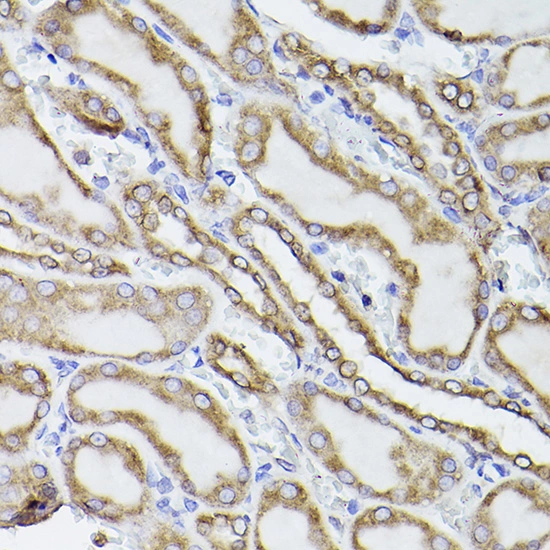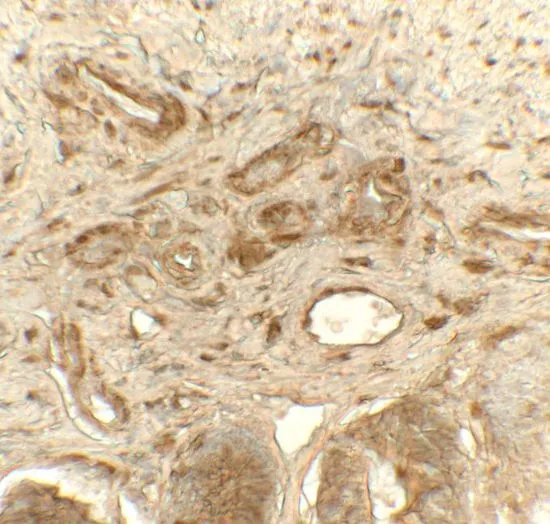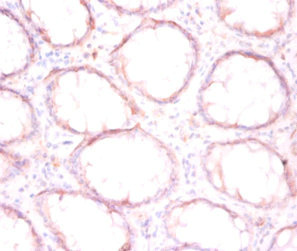PDI antibody [N1N3]
GTX101468
ApplicationsElectron Microscopy, ImmunoFluorescence, Western Blot, ImmunoCytoChemistry, ImmunoHistoChemistry, ImmunoHistoChemistry Paraffin
Product group Antibodies
ReactivityHuman, Mouse, Rat
TargetP4HB
Overview
- SupplierGeneTex
- Product NamePDI antibody [N1N3]
- Delivery Days Customer9
- Application Supplier NoteWB: 1:500-1:10000. ICC/IF: 1:100-1:1000. IHC-P: 1:100-1:1000. *Optimal dilutions/concentrations should be determined by the researcher.Not tested in other applications.
- ApplicationsElectron Microscopy, ImmunoFluorescence, Western Blot, ImmunoCytoChemistry, ImmunoHistoChemistry, ImmunoHistoChemistry Paraffin
- CertificationResearch Use Only
- ClonalityPolyclonal
- Concentration1 mg/ml
- ConjugateUnconjugated
- Gene ID5034
- Target nameP4HB
- Target descriptionprolyl 4-hydroxylase subunit beta
- Target synonymsCLCRP1, DSI, ERBA2L, GIT, P4Hbeta, PDI, PDIA1, PHDB, PO4DB, PO4HB, PROHB, protein disulfide-isomerase, cellular thyroid hormone-binding protein, collagen prolyl 4-hydroxylase beta, glutathione-insulin transhydrogenase, p55, procollagen-proline, 2-oxoglutarate 4-dioxygenase (proline 4-hydroxylase), beta polypeptide, prolyl 4-hydroxylase, beta polypeptide, protein disulfide isomerase family A, member 1, protein disulfide isomerase-associated 1, protein disulfide isomerase/oxidoreductase, protocollagen hydroxylase, testicular secretory protein Li 32, thyroid hormone-binding protein p55
- HostRabbit
- IsotypeIgG
- Protein IDP07237
- Protein NameProtein disulfide-isomerase
- Scientific DescriptionThis gene encodes the beta subunit of prolyl 4-hydroxylase, a highly abundant multifunctional enzyme that belongs to the protein disulfide isomerase family. When present as a tetramer consisting of two alpha and two beta subunits, this enzyme is involved in hydroxylation of prolyl residues in preprocollagen. This enzyme is also a disulfide isomerase containing two thioredoxin domains that catalyze the formation, breakage and rearrangement of disulfide bonds. Other known functions include its ability to act as a chaperone that inhibits aggregation of misfolded proteins in a concentration-dependent manner, its ability to bind thyroid hormone, its role in both the influx and efflux of S-nitrosothiol-bound nitric oxide, and its function as a subunit of the microsomal triglyceride transfer protein complex. [provided by RefSeq]
- ReactivityHuman, Mouse, Rat
- Storage Instruction-20°C or -80°C,2°C to 8°C
- UNSPSC12352203
References
- Leu JG, Wang CM, Chen CY, et al. The Cell Protective Effect of Adenine on Hypoxia-Reoxygenation Injury through PPAR Delta Activation. Life (Basel). 2021,11(12). doi: 10.3390/life11121408Read this paper
- Lee LC, Weng YT, Wu YR, et al. Downregulation of proteins involved in the endoplasmic reticulum stress response and Nrf2-ARE signaling in lymphoblastoid cells of spinocerebellar ataxia type 17. J Neural Transm (Vienna). 2014,121(6):601-10. doi: 10.1007/s00702-013-1157-zRead this paper
- Chen JY, Chou HC, Chen YH, et al. High glucose-induced proteome alterations in hepatocytes and its possible relevance to diabetic liver disease. J Nutr Biochem. 2013,24(11):1889-910. doi: 10.1016/j.jnutbio.2013.05.006Read this paper
- Giordano F, Saheki Y, Idevall-Hagren O, et al. PI(4,5)P(2)-dependent and Ca(2+)-regulated ER-PM interactions mediated by the extended synaptotagmins. Cell. 2013,153(7):1494-509. doi: 10.1016/j.cell.2013.05.026Read this paper
- Shi-Chen Ou D, Lee SB, Chu CS, et al. Transcriptional activation of endoplasmic reticulum chaperone GRP78 by HCMV IE1-72 protein. Cell Res. 2011,21(4):642-53. doi: 10.1038/cr.2011.10Read this paper







